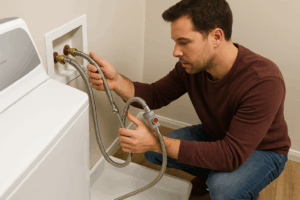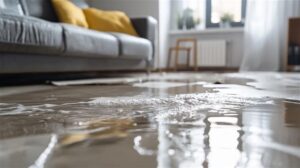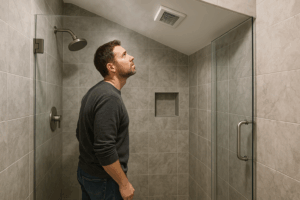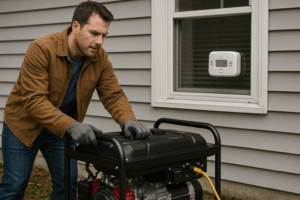The comfort and flexibility of a home office have reshaped the work world. Today more business owners store computers, monitors, files, and confidential information within their homes. However, increased convenience brings greater exposure to risks. Fire threats can impact business continuity, personal safety, and hard-earned assets. Even the smallest spark can destroy years of work, proof of purchase, contracts, and digital archives. Knowing how to protect your environment, both your physical workplace and your vital records, will provide real confidence. This article covers proven methods for limiting fire hazards in your home office, explains how to protect your essential records, and guides you through recovery if disaster strikes.
Why Home Office Fire Safety Matters
Running a business from home means responsibility for your safety, your work, and your future. In traditional offices, building managers monitor fire safety measures, enforce building codes, and maintain alarms. At home, the burden falls on you. Many do not realize that working in shorts with a laptop still requires the same commitment to safety as a high-rise executive suite. Losing equipment or data can paralyze projects, cost clients, and set a business back by months or years. Fires in home offices may result from faulty wiring, improper use of heating equipment, kitchen mishaps, or electrical overload. Keeping your workspace safe from fire means securing your income and peace of mind.
A fire can quickly move from one room to the next, feeding on paper, office chairs, or even dust on electronics. The first step is accepting that disaster can happen, even during normal working hours. Awareness keeps you a step ahead.
Common Fire Hazards in the Home Office
Fire hazards often hide in plain sight. Cords running under rugs, overloaded power strips, cluttered paper piles, candles near files, or space heaters next to a filing cabinet can all turn an ordinary day into a disaster. Many home offices are located in spare rooms or basements where old wiring might go unnoticed or smoke alarms are few.
Electronics generate heat when in use for hours. Surge protectors shield computers but they can overheat when covered or misused. Pets may chew wires hidden behind furniture. Even small lamps and chargers, left on long after work finishes, contribute to the potential for a spark. Home offices rarely feature sprinklers or commercial-grade alarms. Accept small hazards as real threats, and treat every plug, device, and cable as a responsibility.
Effective Fire Prevention Techniques
Taking action before a fire strikes allows you to work confidently. Simple practices lower your risk and create habits that last.
Install smoke detectors outside your work area, above doorways, or in hallways connecting your office to other rooms. Test alarms monthly and replace batteries at least once each year. Modern smoke detectors often chirp when batteries run low, but testing ensures they function properly, even without warning signs. Place a multipurpose fire extinguisher where you can reach it fast. Learn how to use the extinguisher before an emergency makes that impossible.
Choose power strips with surge protection, and check them monthly for fraying or burn marks. Plug only one high-wattage device, such as a heater or printer, into each outlet or strip. Cords should never feel warm when touched. Replace damaged equipment or wiring immediately.
Space heaters bring warmth, but they also increase risk. Select space heaters that switch off if knocked over or left on too long. Place them at least three feet from all papers, books, and files. Never leave a heater running when you leave the room, even for a few minutes. The investment in an auto-shutoff device pays for itself in peace of mind.
Create an emergency plan for yourself and those sharing your home. Walk escape routes, designate meeting points outside the building, and keep doors and hallways clear. Store emergency contact numbers in your phone and print a copy for the fridge. Practice quick exits until everyone can leave calmly, even in poor visibility.
Building Defenses for Physical Documents
Paper documents remain an essential part of many businesses. Licenses, contracts, property deeds, client files, and tax receipts must all survive flames to prevent deeper troubles after a fire. Protecting physical documents starts with organization. Keep important paperwork in one central location. Do not scatter documents across desks, shelves, or drawers. Clutter increases risk and slows quick evacuation.
Invest in a fireproof safe designed for documents. A small but high-quality model such as the Yale Document Fire Safe Home provides up to an hour of fire resistance. This means contracts, certificates, financial records, and irreplaceable files remain intact long enough for the flames to subside or firefighters to respond. Pick a safe with an electronic lock and easy access, but keep the code confidential.
Use labeled folders, envelopes, or waterproof sleeves inside your safe for separation by category. If you keep hard copies of insurance, ID cards, or client data, create a simple index for fast retrieval. Check your safe’s rating before purchase. Look for protection standards against both fire and water. Place the safe against an inside wall, away from windows or heating units, for added protection.
Scan paper documents and keep digital versions as a backup. Although nothing replaces the original for some contracts or legal forms, digitization provides an extra layer of security.
Digital Document Protection for Home Offices
Business today depends on digital tools. Client agreements, tax files, design projects, financial data, and communication records may all exist in electronic form only. Protecting this data from fire means more than keeping computers clean and updated.
Back up critical files daily or weekly, depending on your workflow. Use both external hard drives and reputable cloud services to maintain access in case equipment fails or is destroyed. Store external backups in a fireproof safe specifically rated for digital media. The Phoenix Fireproof Data & Media Safe offers up to two hours of fire resistance, helping you recover valuable work even after disaster strikes.
Cloud storage provides another critical safeguard. Select services that encrypt data both when stored and during transfer. Change passwords regularly and use two-factor authentication where possible. Keep a list of login credentials in a secure password manager.
Digital vaults take safety further. Solutions like Trustworthy enable storage of scanned contracts, licenses, legal agreements, and personal identification. This adds a layer of protection and allows access from anywhere, even if your primary device is offline or destroyed.
Check backup devices every month to confirm files can be restored. A backup that fails when you need it most can have the same impact as never saving the documents at all.
Maintaining Electrical Safety in Your Office
Daily office operations demand power for computers, lamps, printers, and routers. Each device plugged into an outlet brings convenience but also carries the possibility of electrical faults.
Visually inspect cords, outlets, and surge protectors every few weeks. Watch for signs of discoloration, charring, exposed wires, or loose plugs. Replace anything that looks worn immediately. Keep power cords untangled and off the floor whenever possible. Pets, chairs, or foot traffic can damage or disconnect them, creating both shock and fire risks.
Never run cords beneath rugs, mats, or furniture. Heat builds quickly in enclosed spaces, weakening insulation and increasing the chance of ignition. Minimize extension cord use. Instead, reposition your workspace so devices sit closer to permanent wall outlets.
Do not ignore flickering lights or frequent tripped breakers. These may signal a deeper electrical problem in your system. Consult a licensed electrician if you suspect outdated or faulty wiring. Replace all incandescent bulbs with LED versions, which run cooler and use less energy.
Safe Heating Practices
Many offices become cold in winter, especially in basements, spare rooms, or garages. Safe use of supplemental heaters is essential for staying warm without adding risk.
Select heaters with tip-over switches and overheat sensors. Never place heaters on uneven surfaces or near paper, curtains, or furniture. Leave at least three feet of open space on each side of the device.
Plug each heater directly into a wall outlet. Avoid power strips or extension cords that can overheat. Double-check device switches when leaving the room, even if only for a break. Create a habit of turning off all portable heating units before lunch, phone calls, or personal errands.
Check manufacturer guidelines for your heater model, and periodically vacuum dust or debris from intake grilles. Clean heaters work more efficiently and pose less risk of malfunction.
Organizing Home Office Layout for Fire Safety
How you arrange your office influences both safety and your ability to escape quickly. Position your desk and main workspace near doors or windows that serve as secondary exits. Remove obstacles from the main walkway through your office. Store infrequently used items high up and away from heat sources or equipment that generates warmth.
Keep filing cabinets, box stacks, and office supplies away from heaters, radiators, and electrical panels. Reserve space for your fire extinguisher and ensure it is never hidden behind storage bins or locked cabinets.
Mount your smoke detector on the ceiling or high on a wall, away from vents or windows, for best sensitivity. Consider a dual sensor alarm for additional coverage against both fast-burning and smoldering fires.
Create an accessible charging station for electronics. This keeps cables off the floor and prevents accidental unplugging or tripping during an emergency.
Creating and Practicing an Emergency Plan
No prevention plan is complete unless you know exactly what to do if an alarm sounds. Busy workdays and unexpected emergencies challenge clarity, so preparing in advance is critical.
Map out multiple escape routes from your workspace. Identify one main route and one backup, both leading outdoors. Mark locations of smoke detectors and extinguishers. If you work on an upper floor, purchase an escape ladder that fits window sills. Store your phone and keys in one known place every workday.
Include every family member in your planning. Practice leaving the house quickly, timing each exit. Use realistic scenarios, such as rooms filled with simulated smoke, to rehearse responses. Reassure children or others who share your home that preparation increases safety. Plan for pets by designating who will assist them during an emergency.
Keep emergency numbers handy and assign contacting the fire department to one adult in the home. Store a small flashlight and whistle nearby in case of poor visibility.
Protecting Your Data: Backup, Storage, and Redundancy
Backing up business data is mandatory for continuity. Store at least one physical backup on an external drive locked in a fireproof safe. Make it a habit to update this backup regularly. Use automated reminders to prevent missed updates.
Cloud services offer continuous access to vital files, allowing you to recover from loss within hours, not weeks. Use two independent platforms for greater security. If one provider suffers an outage or data loss, your second account stands as a safeguard.
Never rely on a single method. Maintain both off-site and local backups, using fireproof and waterproof storage as a baseline. Audit your backup solutions at least quarterly, making sure file versions are current and recoverable.
Choosing the Right Fire-Safe Solutions
Not all safes protect against fire equally. Read product specifications carefully before purchasing. Seek a fireproof safe with a certified temperature and time rating, indicating how long and at what temperature your possessions remain protected. For document storage, a one-hour rating at 1700 degrees Fahrenheit generally provides reliable protection. For digital media, check compatibility with hard drives, USBs, and backup tapes.
The Yale Document Fire Safe Home stands out for document storage. For digital media, the Phoenix Fireproof Data & Media Safe protects electronics and backup data. Choose a product sized to fit your current files and anticipate future storage needs before purchasing. Install the safe in a cool, dry room, away from sources of vibration or potential flooding.
Do not share safe combinations with anyone outside your family or trusted business partners. Change codes immediately after staff or collaborators leave your business, especially for home-based operations.
Documenting and Safeguarding Insurance Records
Business insurance supports your claims after a fire. Store a hard copy of your active policy, receipts for purchases, and digital proof of coverage inside your fireproof safe. Scan all paperwork as a second safety measure. Update records anytime you add new equipment or expand your home office layout.
Photograph every room of your home office, including contents inside cabinets, drawers, and closets. Save these images in your cloud account and on a USB drive stored away from the office. Careful records help prove ownership and replace inventory without guesswork during claim adjustment.
After Fire Strikes: Step-by-Step Recovery
Responding quickly after fire damage is essential for recovery. First, do not reenter your office until the fire department clears the space for safety. Once allowed inside, document every detail. Take photographs of damaged items, walls, floors, and ceilings. Start an itemized inventory as you walk through the office. Track losses for insurance claims and tax documentation.
Contact a professional restoration service such as All Nation Restoration. Trained experts assess soot, smoke, and structural damage, begin emergency cleanup, and provide an estimate for repairs or replacement. Many services handle board-up, odor removal, and even electronics restoration. The sooner you act, the more likely valuable records and equipment can be salvaged.
Notify your insurance provider promptly once damages are assessed. Share detailed records, photos, and receipts. Most companies require this documentation before processing claims. Keep digital copies for reference and communication.
Recover your digital records by restoring from backup drives or cloud platforms immediately after the area is declared safe. If you stored data on fire-resistant devices or in an external location, recovery can be almost instantaneous. Scan retrieved documents for damage or corruption. Compare restored files with your most recent backup to confirm nothing is missing. Seek professional IT support if files appear inaccessible or damaged, as specialized services can sometimes recover data from scorched media.
Staying Updated: Periodic Review and Maintenance
Fire safety and digital document protection require attention year-round. Update your prevention habits every season. As equipment gets replaced, documents pile up, or office layouts shift, renew your checks. Test smoke alarms, check safe locks, verify backup schedules, and scan new files into your secure storage.
Read up on product advancements for safes and digital storage options at least once a year. Attend safety trainings online or in your community when possible. Even a single improvement in your processes can prevent major losses in the future.
Share your safety routines with team members or family. Assign roles in emergencies and keep everyone involved. Security improves when multiple people understand procedures.
Total Protection Brings Peace of Mind
Combining practical fire prevention, strong digital document protection, and a clear recovery plan means your home office becomes a resilient powerhouse. Structure your daily work with safety at its core. Organize, digitize, and protect everything critical to your success. Review insurance coverage and recovery steps before you ever need them. Home office fire safety is not just about preserving your physical workspace. It preserves your income, reputation, and future opportunities.







